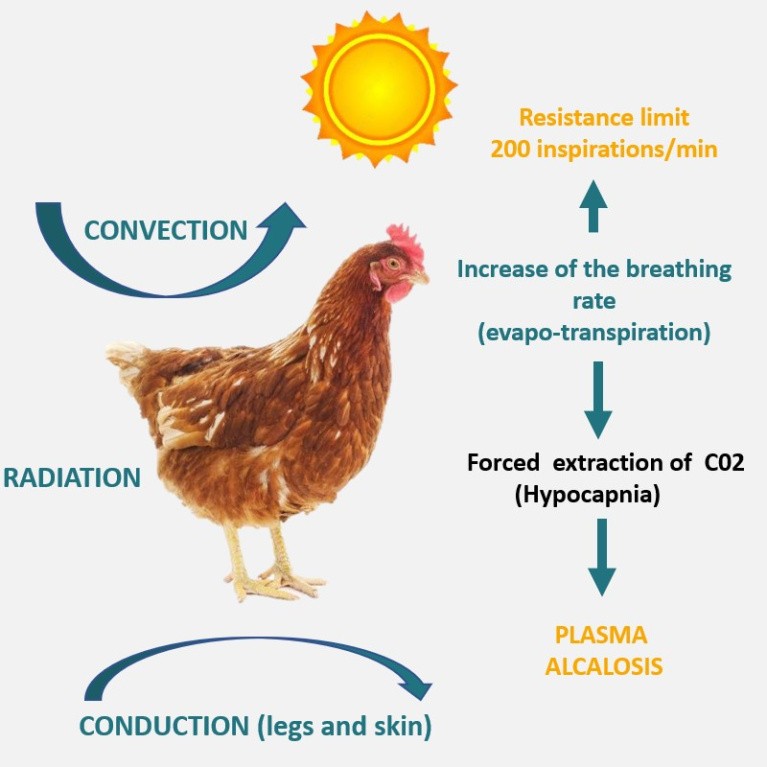Increasingly intense heat waves are threatening the health, well-being and productivity of poultry. Between heat stress and a drop in performance, poultry farmers and professionals are having to adjust their practices to preserve their business. What are the repercussions and strategies for adapting to global warming in the poultry industry?
Thermoregulation in poultry
Poultry do not have sweat glands, which complicates their thermoregulation. To cool down, they increase their breathing rate, which leads to a loss of carbon dioxide and upsets their body's acid-base balance. This method of regulation is therefore limited, and beyond a certain threshold, the animal is in danger.
To summarise, poultry evacuate their heat mainly by :
- Sensible heat: losses by convection (heat exchanges with the surrounding air), conduction (featherless areas) and radiation.
- Latent heat: evaporation via accelerated respiration, which reaches a physiological limit above 200 breaths per minute.
"Heat stress occurs much earlier than we think: from 24°C with 70% humidity, poultry are already beginning to suffer the consequences.
Frédéric Lemane, Techna poultry engineer

The consequences of hyperthermia in poultry farming
In hot weather, poultry will start to drink more, with water/feed ratios as high as a factor of 4. At the same time, there is a reduction in feed intake and poorer digestion due to a drop in enzyme activity. This drop in digestibility can be as much as 20% for proteins and 10% for starch, while the digestibility of fats remains stable. Less intake coupled with lower feed digestibility. Result: growth is penalised. In addition, organs linked to immunity, such as the bursa of Fabricius (involved in the production of B lymphocytes), can lose up to 50% of their mass. This makes poultry more susceptible to certain diseases. The increased respiratory rate resulting from heat stress can also cause plasma alkalosis (increased blood pH).
The impact of global warming on the poultry industry
Prolonged hot spells are causing major economic losses for the poultry industry. Reduced egg quality, increased chick mortality and lower meat yields are all economic and production challenges for the industry as a whole.
- Reproduction: reduction in the immune quality of chicks, deterioration in hatchability and vigour.
- Chicken production: drop in fillet yields and accumulation of excessive abdominal fat.
- Laying: drop in shell quality and performance of layers.
- Growth: reduction in Average Daily Gain (ADG), impacting profitability.
- Animal health and welfare: discomfort, nervousness and immunosuppressive effect.

Adapting buildings to climate change
Improving buildings is one way of limiting the impact of heat stress. This involves optimising natural and mechanical ventilation systems and improving insulation. Farmers can also install misting and evaporative cooling systems (pad cooling), adapted to dry climates. Finally, outside, planting trees or hedges nearby can reduce the rise in temperature inside the buildings.

Good husbandry practices for hot weather
1 - Ventilate and refresh drinking water
Good air circulation in the buildings is essential to limit the rise in the birds' body temperature. It is also vital to keep drinking water at a cool temperature. Water that is too hot reduces consumption and increases heat stress. Installing pipe insulation systems, shading tanks and using well-positioned drinking troughs all help to keep water at the right temperature.
2 - Combating plasma alkalosis
Hyperventilation leads to excessive loss of CO2, causing plasma alkalosis. Adding sodium bicarbonate (0.5%) to drinking water helps to regulate blood pH and maintain performance.
3 - Repairing oxidative damage
Prolonged exposure to heat causes oxidative stress. Free radicals cause damage to DNA, proteins and lipids. The addition of antioxidants, in particular vitamins C and E, helps to protect liver cells and improve the resilience of poultry.
4 - Adjusting animal nutrition
Feed formulation needs to be reviewed to meet energy requirements while minimising digestive impact.
- Maintain a stable energy intake without excessively increasing gross energy.
- Moderate protein reduction to avoid excessive heat production during digestion.
- Increase in fat to improve palatability and energy efficiency and, above all, limit the production of extra heat.
Preventive measures for the poultry industry in the medium and long term
Genetic adaptations and pre-conditioning strategies can improve the resilience of the poultry industry in the face of global warming:
- Selection of strains better adapted to hot climates
- Development of poultry lines with less plumage to facilitate heat dissipation. However, the gene that codes for the naked neck is incompatible with net yield and growth.
- Heat pre-conditioning in hatcheries and rearing facilities to improve the heat tolerance of chicks.
Conclusion
-
Global warming is a reality facing poultry farms around the world.
-
The economic consequences are serious and will continue to be so (a 20% drop in chicken growth at 35 days, for example).
-
Faced with increasingly extreme weather conditions, poultry industry professionals are having to adapt by combining short-, medium- and long-term solutions.
-
These efforts are essential if we are to guarantee the long-term future of poultry production in a changing environment.
Talk to our experts
Feedia embodies Techna's range of advice and solutions in breeding techniques and precision nutrition, serving the performance of production organisations, feed manufacturers and their breeder customers.


